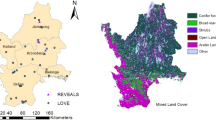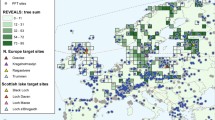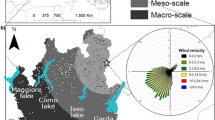Abstract
Palaeoecological data are compared with output from climate-driven forest simulation models to separate human influence as a driver of vegetation dynamics from other drivers such as climatic change. The transition from Tilia cordata to Fagus sylvatica dominance in a small forest hollow in Denmark was not predicted by a climate-driven forest simulation model and could be ascribed to anthropogenic impact. This transition can be upscaled to a large region of north-west Europe and contributes to a data-model mismatch for the European distribution of Fagus 6,000 years ago. A data-model mismatch for Picea abies during the last few centuries in southern Scandinavia can also be attributed to anthropogenic impact. Combining pollen data and vegetation models can help with the important task of upscaling from the scale of the forest stand, where anthropogenic impact is readily detectable, to regions and continents, where it is more challenging to distinguish anthropogenic impact from the impacts of climatic change.



Similar content being viewed by others
References
Aaby B f(1983) Forest development, soil genesis and human activity illustrated by pollen and hypha analysis of two neighbouring podzols in Draved Forest, Denmark. Danmarks Geologiske Undersøgelse II 114:1–114
Behre KE (1988) The role of man in European vegetation history. In: Huntley B, Webb T III (eds) Vegetation history. Kluwer, Dordrecht, pp 633–672
Berglund BE (1991a) The cultural landscape during 6,000 years in southern Sweden, the Ystad project. Munksgaard, Copenhagen
Berglund BE (1991b) Pollen proxy data from the Nordic countries. In: Frenzel B (ed) Evaluation of climate proxy data in relation to the European Holocene. Fischer, Stuttgart, pp 29–36
Björkman L, Bradshaw RHW (1996) The immigration of Fagus sylvatica L. and Picea abies (L.) Karst into a natural forest stand in southern Sweden during the last 2,000 years. J Biogeogr 23:235–244
Bradshaw RHW (1988) Spatially-precise studies of forest dynamics. In: Huntley B, Webb T III (eds) Vegetation history. Kluwer, Dordrecht, pp 725–751
Bradshaw RHW, Holmqvist BH (1999) Danish forest development during the last 3000 years reconstructed from regional pollen data. Ecography 22:53–62
Bradshaw RHW, Lindbladh M (2005) Regional spread and stand-scale establishment of Fagus sylvatica and Picea abies in Scandinavia. Ecology 86:1679–1686
Bradshaw RHW, Tolonen K, Tolonen M (1997) Holocene records of fire from the boreal and temperate zones of Europe. In: Clark JS, Cachier H, Goldammer JG, Stocks BJ (eds) Sediment records of biomass burning and global change. NATO ASI Series I: Global environmental change 51. Springer, Berlin, pp 347–365
Bradshaw RHW, Holmqvist BH, Cowling SA, Sykes MT (2000) The effects of climate change on the distribution and management of Picea abies in southern Scandinavia. Can J For Res 30:1992–1998
Bradshaw RHW, Wolf A, Møller PF (2005) Long-term succession in a Danish temperate deciduous forest. Ecography 28:157–164
Briffa KR, Jones PD, Bartholin TS, Eckstein D, Schweingruber FH, Karlen W, Zetterberg P, Eronen M (1992) Fennoscandian summers from AD 500: temperature changes on short and long time scales. Clim Dyn 7:111–119
Cowling SA, Sykes MT, Bradshaw RHW (2001) Palaeovegetation-model comparisons, climate change and tree succession in Scandinavia over the past 1500 years. J Ecol 89:227–236
Davis MB, Botkin DB (1985) Sensitivity of cool-temperate forests and their fossil pollen record to rapid temperature-change. Quat Res 23:327–340
Davis MB, Calcote RR, Sugita S, Takahara H (1998) Patchy invasion and the origin of a hemlock-hardwoods forest mosaic. Ecology 79:2641–2659
Gaillard MJ, Birks HJB, Emanuelsson U, Karlsson S, Lageras P, Olausson D (1994) Application of modern pollen land-use relationships to the interpretation of pollen diagrams––reconstructions of land-use history in south sweden, 3,000-0 BP. Rev Palaeobot Palynol 82:47–73
Gardner AR, Willis KJ (1999) Prehistoric farming and the postglacial expansion of beech and hornbeam: a comment on Küster. The Holocene 9:119–122
Giesecke T, Bennett KD (2004) The Holocene spread of Picea abies (L.) Karst. in Fennoscandia and adjacent areas. J Biogeogr 31:1523–1548
Giesecke T, Hickler T, Kunkel T, Sykes MT, Bradshaw RHW (2007) Towards an understanding of the Holocene distribution of Fagus sylvatica L. J Biogeogr 34:118–131
Gliemeroth AK (1995) Paläoökokologische Untersuchungen über die letzten 22000 Jahre in Europa: Vegetation, Biomasse und Einwanderungsgeschichte der wichtigsten Waldbäume. Fischer, Stuttgart
Huntley B, Prentice IC (1993) Holocene vegetation and climates of Europe. In: Wright HE Jr, Kutzbach JE, Webb T III, Ruddiman WF, Street Perrott FA, Bartlein PJ (eds) Global climates since the last glacial maximum. University of Minnesota Press, Minneapolis, pp 136–168
Iversen J (1969) Retrogressive development of a forest ecosystem demonstrated by pollen diagrams from fossil mor. Oikos Suppl 12:35–49
Iversen J (1973) The development of Denmark’s nature since the Last Glacial. Danmarks Geologiske Undersøgelse Række V 7C:1–126
Jalas J, Suominen J (1972–99) Atlas Florae Europaeae: distribution of vascular plants in Europe. Vol. 1–9. The Committee for mapping the flora of Europe and Societas biologica Fennica Vanamo, Helsinki
Keller F, Lischke H, Mathis T, Möhl A, Wick L, Ammann B, Kienast F (2002) Effects of climate, fire and humans on forest dynamics: forest simulations compared to the palaeoecological record. Ecol Modell 152:109–127
Küster H (1997) The role of farming in the post-glacial expansion of beech and hornbeam in the oak woodlands of central Europe. Holocene 7:239–242
Lamb HH (1967) The early Medieval warm epoch and its sequel. Palaeogeogr Palaeoclimatol Palaeoecol 1:13–37
Lischke H, Lotter AF, Fischlin A (2002) Untangling a Holocene pollen record with forest model simulations and independent climate data. Ecol Modell 150:1–21
Magri D, Vendramin GG, Comps B, Dupanloup I, Geburek T, Gömöry D, Latalowa M, Litt T, Paule L, Roure JM, Tantau I, van der Knaap WO, Petit RJ, de Beaulieu JL (2006) A new scenario for the Quaternary history of European beech populations: palaeobotanical evidence and genetic consequences. New Phytol 171:199–221
Mann ME, Bradley RS, Hughes MK (1999) Northern hemisphere temperatures during the past millennium: Inferences, uncertainties, and limitations. Geophys Res Lett 26:759–762
Prentice IC, Sykes MT, Cramer W (1993) A simulation-model for the transient effects of climate change on forest landscapes. Ecol Modell 65:51–70
Ruddiman WF (2003) The anthropogenic greenhouse era began thousands of years ago. Clim Change 61:261–293
Ruddiman WF (2005) The early anthropogenic hypothesis a year later. Clim Change 69:427–434
Sugita S, Gaillard MJ, Broström A (1999) Landscape openness and pollen records: a simulation approach. Holocene 9:409–421
Sykes MT, Prentice IC, Cramer W (1996) A bioclimatic model for the potential distributions of north European tree species under present and future climates. J Biogeogr 23:203–233
Tinner W, Lotter AF (2006) Holocene expansion of Fagus silvatica and Abies alba in Central Europe: where are we after eight decades of debate? Quat Sci Rev 25:526–549
Turner J (1962) The Tilia decline: an anthropogenic interpretation. New Phytol 70:328–341
Acknowledgments
The work was financed through project DECVEG, which is part of the ESF EUROCLIMATE programme and FORMAS 239-2001-2818.
Author information
Authors and Affiliations
Corresponding author
Additional information
Communicated by M.J. Bunting.
Rights and permissions
About this article
Cite this article
Bradshaw, R.H.W. Detecting human impact in the pollen record using data-model comparison. Veget Hist Archaeobot 17, 597–603 (2008). https://doi.org/10.1007/s00334-007-0116-8
Received:
Accepted:
Published:
Issue Date:
DOI: https://doi.org/10.1007/s00334-007-0116-8




